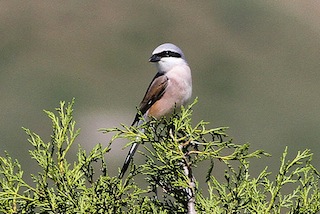 Now pretty much extinct as a breeding species in the UK, you might spot a Red-backed Shrike on The Lizard during its autumn migration back to Africa.
Now pretty much extinct as a breeding species in the UK, you might spot a Red-backed Shrike on The Lizard during its autumn migration back to Africa.
Photo: Ron Knight
Scientific name: Lanius collurio
Other common names: Butcher Bird
Conservation status: UK Birds of Conservation Concern, Red; IUCN Red List, Least Concern
What to look for:
- Colouring and appearance: Males – rusty red upper parts, blue-grey head, black eye-stripe, pinkish underparts and black and white tail. Females and juveniles – brown vermiculated upperparts and paler underparts, also vermiculated.
- Size: Length 16 to 18 cm, wingspan 26 cm.
- Where: Native to Europe and western Asia in breeding season; winters in Africa. Seen in the south and east of the UK on migration.
- Call: Warbling song by male; ‘chack-chack’ alarm calls.
 It’s rare to spot a Red-backed Shrike these days. The species is as good as extinct as a breeding bird in the UK, with only a small handful of pairs breeding per year, and only about 250 individuals passing through as migrants in the spring and autumn, mainly on the south and east coasts, including Cornwall.
It’s rare to spot a Red-backed Shrike these days. The species is as good as extinct as a breeding bird in the UK, with only a small handful of pairs breeding per year, and only about 250 individuals passing through as migrants in the spring and autumn, mainly on the south and east coasts, including Cornwall.
Red-backed Shrikes used to be a much more common summer breeding visitor here, but numbers have declined since the middle of the nineteenth century. More recently (since 2010), one or two pairs have nested and successfully raised young on Dartmoor – see this BBC news report – and they have also bred sporadically in Scotland and Wales, but always in very small numbers. The reason for the dramatic decline in the UK is not clear, but factors could include loss of habitat due to scrub clearance and reduction of prey through agricultural use of pesticides.
The Red-backed Shrike’s breeding habitat includes hedgerows, scrub and heathland. The moss- and hair-lined nest is perched in thorny shrubs, such as gorse, and the female lays a clutch of three to six eggs. The pair raise a single brood each year.
One of their best-known characteristics is their habit of impaling their prey (usually insects and small mammals) on sharp thorns or wedging them in forks, creating a larder that they can return to when prey is less available. This has earned them the nickname ‘Butcher Bird’. Red-backed Shrikes hunt from prominent perches, giving them a good view of prey. They chase after flying insects, but will also drop onto insects, reptiles and small mammals wandering along unsuspectingly below their perch. Watch this short RSPB video of a female eating her impaled prey.
Did you know…?
…In folklore, it was believed that the Red-backed Shrike would only begin eating after it had killed and stored nine items of prey.
…The genus name Lanio is from the Latin for ‘butcher’.
More information and references:
Svensson, L., Mullarney, K., Zetterstrom, D.,1986. Collins Bird Guide, second edition (translated by Christie, D., Svensson, L.). HarperCollins, London.
Published: October 2014
Author: Amanda Scott
Photos: Ron Knight from Seaford, East Sussex, United Kingdom [CC-BY-2.0]
